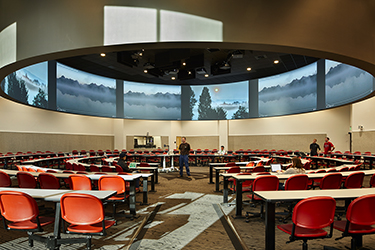|
Subscribe / Renew |
|
|
Contact Us |
|
| ► Subscribe to our Free Weekly Newsletter | |
| home | Welcome, sign in or click here to subscribe. | login |
Construction
| |
 |
May 11, 2018
Design-build done right: tips for success
Clark Construction Group

Earnest
|
Successful design-build projects provide a multitude of value to the owner, and ultimately to the end users.
These benefits include improved project quality, as well as time and cost savings. Design-build delivery also allows the contractor to establish a guaranteed budget early in the design phase. As a result, the owner can make changes, request additional value engineering or even add scope to a project before the substantial design is complete.
The Spark, Washington State University’s new digital classroom building, serves as an example of how design-build can work successfully. The Spark was the product of a design-build competition and delivery that allowed WSU to find the best value design and team for the university’s budget.
The academic innovation hub and revolutionary teaching and learning space creates an environment that energizes and connects students and faculty. The 83,000-square-foot, high-performance academic building boasts a 250-seat innovative circular learning hall, faculty innovation studio, hoteling office space, media studio with 3-D printers, cafe, student development studio and event space.
Employing the best practices outlined below, Clark Construction Group and ZGF Architects delivered the $43 million design-build project for WSU early and under budget, while incorporating numerous technological and student experience enhancements.
Goals and mission
To attain the best possible outcome, design-build teams should align with the client around attaining the project goals and client’s mission from the outset. Prioritizing deep and broad engagement with the client — even during the procurement process in proprietary meetings — helps set a collaborative tone early in the project.
On The Spark, the client, architect and contractor fostered a culture of transparency and trust from the start. While WSU was the client, the needs of the students, faculty and Pullman community became equally important to the team throughout the process, from the planning phase to final inspection.
To enhance team collaboration and expedite critical decision making, Clark co-located with the design team and other key consultants. The team worked towards a 100 percent integrated virtual co-location that included regular design staff rotation on-site, video-enhanced conferencing and collaborative online work sessions facilitating long-distance teamwork.
Co-location yielded a more streamlined decision-making process, which ultimately benefited the project schedule. While design-build delivery can be perceived as limiting client access to the architect, the opposite is true if a team is committed to maximizing efficiency and collaboration among stakeholders. Providing full access to the design team ensures faster responses and opens communication at all levels.
Flexibility
Remaining flexible to respond to changing project conditions and needs is equally critical in a design-build project. Design-build provides the flexibility to respond to — and incorporate — a client’s evolving needs with tailor-made solutions. The project team, in turn, can drive creative solutions that bring value, which are often hallmarks of a successful design-build project.
The Clark/ZGF team surmounted challenges at each stage of The Spark project, including an already tight budget further reduced by state funding cuts, incorporating updated university construction standards into the design, a restricted site, and rapidly evolving technology market.
After reducing overall project costs by $5 million at the start of the project, the team later incorporated $750,000 in building design enhancements and still completed the project $127,000 under budget.
During the design and validation period, WSU released new construction standards that revised the standards to which the Clark/ZGF contract and design were based upon. To meet WSU’s new quality, safety and operational requirements, the team held detailed coordination meetings with all stakeholders to revise the design. Because of the process, the team discovered cost-saving opportunities across trades that opened the door for later building enhancements.
The constant review of budgets, transparent cost reporting and detailed allowance management process ensured the delivery of a state-of-the-art building with significant technology upgrades without impacting the schedule or increasing overall construction cost.
Team mentality
Perhaps most importantly, fostering a “one team” mentality is critical to achieving design-build success. Open lines of communication among designers, subcontractors, user groups, and the construction team allows for maximum efficacy of coordination. During design and construction of The Spark, “TEAM” was written on the wall in the co-location space to signify the complete ownership of all stakeholders at all levels.
The team worked together to address challenges affecting cost and schedule, safety and quality, and The Spark’s need for innovative digital technologies. Clark and ZGF reviewed challenges in the field with the client daily and held collaborative work sessions multiple times a week. Project leaders throughout the design and construction process carried a spark of innovation that epitomized their finished product.
The team mentality extended beyond the jobsite, with Clark team members becoming engaged throughout the local community. For example, the team worked with first responders on an emergency action plan that was later adopted by WSU as the new standard. They also worked with the local Boy Scouts and joined WSU’s Butch Cougar mascot program in performing athletic and community service activities on campus.
Design-build success
Early alignment with WSU around project goals, the agility to respond to evolving project conditions and always maintaining a team mentality were all critical to the success of this design-build project. Adhering to these best practices requires a significant investment in the process. Every design-build partnership is different but committing to fostering a truly collaborative team environment can go a long way towards ensuring project success.
WSU sought a revolutionary teaching and learning space that enables faculty to use the most innovative technology, while also helping students engage deeply in learning. Clark and ZGF worked hand-in-glove to deliver a facility that exceeded the client’s vision for functionality, quality and aesthetics, while staying within the budget.
The Spark embodies a holistic understanding of higher education construction and a desire to further WSU’s mission and enhance the learning environment for university students and staff alike. The result is an academic building that leaves a lasting mark on the community and has been recognized for building and design excellence by regional and national industry organizations.
Brett Earnest is a vice president with Clark Construction Group in Seattle. Clark has delivered nearly $20 billion of design-build projects across the country.
Other Stories:
- Eagle of Excellence
Tenant Improvement/Renovation
$4 million-$10 million - Specialty Construction Commercial
less than $5 million - Merit Award Industrial
$5 million-$15 million - Merit Awards Infrastructure
up to $100 million - Merit Award Institutional
less than $5 million - Merit Award Tenant Improvement/Renovation
less than $4 million - Merit Award Tenant Improvement/Renovation
$4 million-$10 million - Survey: Lease Crutcher Lewis
- Survey: Skanska USA
- Survey: Schuchart
- Survey: The Walsh Group
- Survey: Synergy Construction
- Mechanical/Industrial
less than $5 million - Multifamily Construction
$25 million-$100 million - The coming workforce challenge: filling 1M jobs
- Seattle braces for metal tariff fallout
- Here’s how a modular hotel stacks up in Seattle
- We’ve got green buildings, how about green communities?
- Tight site, deep hole? Bring on the teledipper
- Equipment sector’s heavy lift: regulations, employees
- Pyramid Award
Other Construction
$10 million-$25 million - Commercial Construction
$10 million-$25 million - Commercial Construction
$5 million-$10 million - Commercial Construction
less than $5 million - Healthcare less than $10 million
- Survey: Absher Construction Co.



